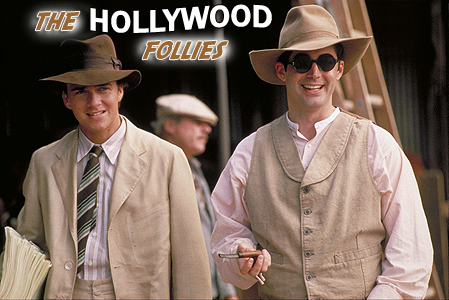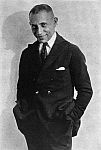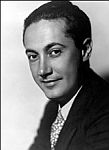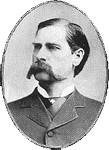Scandal of 1920 | Hollywood Follies
Young Indy Home
Chapter Overview

In this tale of "silent" entertainment, Indiana Jones accepts a job in Hollywood where he is charged with halting the production of an overbudget movie. The task seems simple enough, but when the producer of the film is Erich von Stroheim, ending the production of a major movie is out of the question. Indy conspires with the new studio executive, Irving Thalberg, to take the film away from Von Stroheim. After experiencing the "behind-the-scenes" side of Hollywood, Indy decides that he might do better in front of the camera... in a John Ford western. However, Indy gets more than he bargained for when one of the actors accidentally dies and he is asked to be the replacement. In desperate need of aid, Indy gets acting tips from silent film star Harry Carey and advice on authenticity from infamous lawman Wyatt Earp. Indy's big finale comes when he must stop a runaway carriage by jumping from the carriage to the horse team. This stunt becomes more exciting when Indy falls beneath the horse team and he is dragged under the carriage. This stunt will serve Indy "well" when he visits Egypt in another 15 years or so.
Key Topics: | 1920's Hollywood; Rise of Hollywood & Movies; Silent Films; Film Production |
Historic People: | Erich von Stroheim—One of Hollywood's earliest pioneers whose reputation and arrogance got him fired from nearly every studio he worked for. |
People and Topics
DescriptorOne of Hollywood's earliest pioneers whose reputation and arrogance got him fired from nearly every studio he worked for. BooksKoszarski, Richard. Von: The Life and Films of Erich von Stroheim. New York: Limelight Editions, 2001. Lennig, Arthur. Stroheim. Lexington, KY: The University Press of Kentucky, 2000. Websites |
DescriptorOne of Hollywood's most successful filmmakers who set a new standard in Hollywood. He is also the namesake for the Thalberg Award, which is awarded to "creative producers personally responsible for a consistently high quality of motion picture production." BooksSchatz, Thomas. The Genius of the System: Hollywood Filmmaking in the Studio Era. New York: Henry Holt and Company, Inc., 1996. Flamini, Roland. Thalberg: The Last Tycoon and the World of M-G-M. New York: Crown Publishers, Inc., 1994. Websites |
DescriptorLegendary Hollywood Director of such classics as Steinbeck's The Grapes of Wrath. BooksEyman, Scott. Print the Legend: The Life and Times of John Ford. New York: Simon and Schuster, 1999. McBride, Joseph. Searching for John Ford: A Life. New York: St. Martin's Press, 2001. Websites |
DescriptorLegendary and infamous lawman of the old west. Gained fame from the showdown at the O.K. Corral, where Earp and his cohorts gunned down the Clantons. Earp served out his final years in Hollywood as an advisor for accurate westerns. BooksTefertiller, Casey. Wyatt Earp: The Life Behind the Legend. Wiley, 1999. Lake, Stuart. Wyatt Earp: Frontier Marshal. Pocket, 1994. Websites |
DescriptorFollowing World War I, movies exploded on to the American scene, becoming everyone's favorite form of entertainment. Although movies of this time were silent, that didn't stop people from filling theaters in droves. In the process, a small place in California called Hollywood grew to become the heart of America's film industry. BooksThompson, David. The Whole Equation: A History of Hollywood. New York: Alfred A. Knopf, 2005. Schatz, Thomas. The Genius of the System: Hollywood Filmmaking in the Studio Era. New York: Henry Holt and Company, Inc., 1996. Websites |
Disclaimer: All resources (including books and websites) provided on indyintheclassroom.com are intended to be used by educators. Indyintheclassroom.com is not responsible for the content on linked websites.
Copyright: All images on Indyintheclassroom.com are used with permission or are in the public domain. Exceptions are noted. For additional information see our Copyright section. |
Documentary Previews
Below you will find information about each documentary that supplements The Hollywood Follies.
Erich von Stroheim: The Profligate Genius | He was unmistakable. With his suave demeanor, impeccable wardrobe and bullet head, on screen Erich Von Stroheim played sadistic and sometimes seductive Prussians. As a director, von Stroheim earned a reputation for unparalleled egomania, arrogance and self indulgence. Though he was fired by nearly every studio he worked for and most of his films he directed were finished by others, or destroyed, what remains offers a glimpse of one of Hollywood's pioneers, one whom everyone loved to hate. Produced by Adam Sternberg. Running Time: (0:32:52) |
The Rise of the Moguls: The Men Who Built Hollywood | To the outside world Hollywood seemed like a magic place. Here, the sun was always shining, everyone had a swimming pool, and glamorous people earned enormous salaries working in factories called movie studios. Every year millions of fans bought tickets to see the studios' latest releases, but no one traveled farther to get here, or worked harder to get to the top, than the men who built the studios and ruled them like feudal overlords. Men who started out with nothing, and transformed themselves into Hollywood's movie Moguls. Produced by Mark Page and Jennifer Petrucelli. Running Time: (0:25:40) |
Irving Thalberg: Hollywood's Boy Wonder | Named for one of Hollywood's most legendary filmmakers, the Thalberg Award is given to "creative producers personally responsible for a consistently high quality of motion picture production." A standard of quality set during Hollywood's golden age, by Irving G. Thalberg himself. Produced by Mark Page and Jennifer Petrucelli. Running Time: (0:32:30)
|
The World of John Ford | People called it the Dust Bowl, an environmental disaster that struck the Great Plains in the late 1930s, when the country was already reeling under the Depression. John Steinbeck's best-selling novel, The Grapes of Wrath, profiled some of the hardest hit: tenant farmers forced off their land and into migrant labor far from home. When the movie version was announced, people worried that Hollywood would ruin it. They didn't need to. It was directed by John Ford. Produced and Written by Sharon Wood. Running Time: (0:33:18) |
Disclaimer: All resources (including books and websites) provided on indyintheclassroom.com are intended to be used by educators. Indyintheclassroom.com is not responsible for the content on linked websites.
Copyright: All images on Indyintheclassroom.com are used with permission or are in the public domain. Exceptions are noted. For additional information see our Copyright section. |
Indy Connections: The Hollywood Follies
Below are current event articles that relate to events, topics, and people found in The Hollywood Follies.
We all know the classic First World War films - but what of flops and political embarrassments?
independent.co.uk
5/28/2014
Movie legends including Charlie Chaplin, Stanley Kubrick and Steven Spielberg have attempted to tackle the First World War, but while some have achieved Oscars and box-office success, others have delayed peace talks and enraged renowned world leaders. One of the most famous films, A Farewell to Arms (1932), directed by Frank Borzage, has been digitally restored and is due for re-release in UK cinemas tomorrow.
The History of the Flapper, Part 3: The Rectangular Silhouette
2/19/2013
If a woman in the 1920s had a boyish figure and was naturally skinny, she was all set to slip on a slim sheath, a signature look of the 1920s. But if she was plump and curvaceous, she might choose certain undergarments to help achieve the fashionable unisex flapper shape. The flapper silhouette was distinctive, and if you’re a fan of PBS’s “Downton Abbey,” you’ve seen it in full effect this season: angular (basically rectangular), androgynous, slender and straight. It was influenced by Braque, Picasso, Leger and others artists whose work had hard, geometric forms and visible lines.
The History of the Flapper, Part 2: Makeup Makes a Bold Entrance
Smithsonian.com
2/7/2013
In the decades before the Roaring Twenties, nice girls didn’t wear makeup. But that changed when flappers began applying cosmetics that were meant to be noticed, a reaction to the subdued and feminine pre-war Victorian attitudes and styles typified by the classic Gibson girl. Before the 1920s, makeup was a real pain to put on. It’s no wonder women kept it to a minimum. The tubes, brushes and compacts we take for granted today hadn’t yet been invented. Innovations in cosmetics in the ’20s made it much easier for women to experiment with new looks. And with the increasing popularity of movies, women could mimic the stars—like Joan Crawford, Mae Murray and Clara Bow, an American actress who epitomized the flapper’s spitfire attitude and heavily made-up appearance.
The History of the Flapper, Part 1: A Call for Freedom
Smithsonian.com
2/5/2013
In the age before the Roaring Twenties, women were still wearing floor-length dresses. Waists were cinched. Arms and legs were covered. Corsets were standard on a daily basis. Hair was long. The Gibson girl was the idealized image of beauty. And the Victorian attitudes toward dress and etiquette created a strict moral climate. Then the 1920s hit and things changed rapidly. The 19th Amendment passed in 1920 giving women the right to vote. Women began attending college. The Equal Rights Amendment was proposed by Alice Paul in 1923. World War I was over and men wanted their jobs back. Women, though, who had joined the workforce while the men were at war, had tasted the possibility of life beyond homemaking and weren’t ready to relinquish their jobs. Prohibition was underway with the passing of the 18th Amendment in 1919 and speakeasies were plentiful if you knew where to look. Motion pictures got sound, color and talking sequences. The Charleston’s popularity contributed to a nationwide dance craze. Every day, more women got behind the wheels of cars. And prosperity abounded.
The “Latin Lover” and His Enemies
Smithsonian.com
6/13/2012
With the Roaring Twenties in full swing and the first talkies on the horizon, Hollywood’s booming film industry already had its share of bankable stars—Charlie Chaplin, Greta Garbo, Douglas Fairbanks, Buster Keaton. But in the summer of 1926, an Italian immigrant named Rodolfo Alfonso Rafaello Pierre Filibert Guglielmi di Valentina D’Antonguolla would join them. Known as the “Latin Lover,” Rudolph Valentino would, by summer’s end, single-handedly change the way generations of men and women thought about sex and seduction.
Hollywood's Historic Buildings
Smithsonian.com
3/1/2010
The Day of the Locust Director John Schlesinger once said of Hollywood, "[it] is an extraordinary kind of temporary place." Fame may be fleeting, but when it comes to Hollywood architecture "preservation" is now the watchword. Thanks to the efforts of private companies and such preservation groups as Hollywood Heritage and the Los Angeles Conservancy, dozens of historic buildings in the area have been rescued.
Louis B. Mayer Invents a Hollywood Dream Machine
AmericanHeritage.com
11/28/2007
November 28, 1907, was a big day in the history of dreams. On that day, exactly 100 years ago, a half-educated scrap-metal dealer opened a 600-seat movie theater in a converted burlesque house in Haverhill, Massachusetts. It was the beginning of a climb that would take him to the top of the most important movie studio in the world.
Disclaimer: All resources (including books and websites) provided on indyintheclassroom.com are intended to be used by educators. Indyintheclassroom.com is not responsible for the content on linked websites.
Copyright: All images on Indyintheclassroom.com are used with permission or are in the public domain. Exceptions are noted. For additional information see our Copyright section. |
Scandal of 1920 | Hollywood Follies
Young Indy Home




